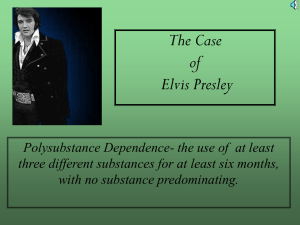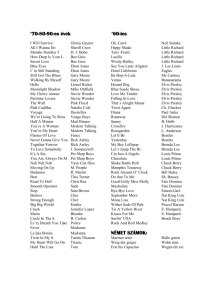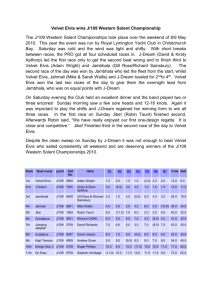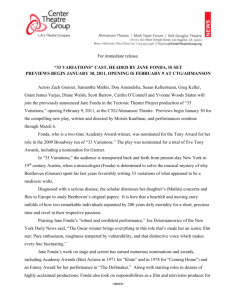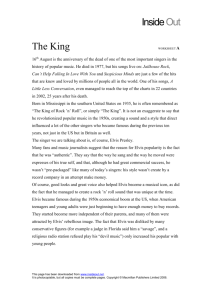Sacred and profane icon-work: Jane Fonda and Elvis Presley
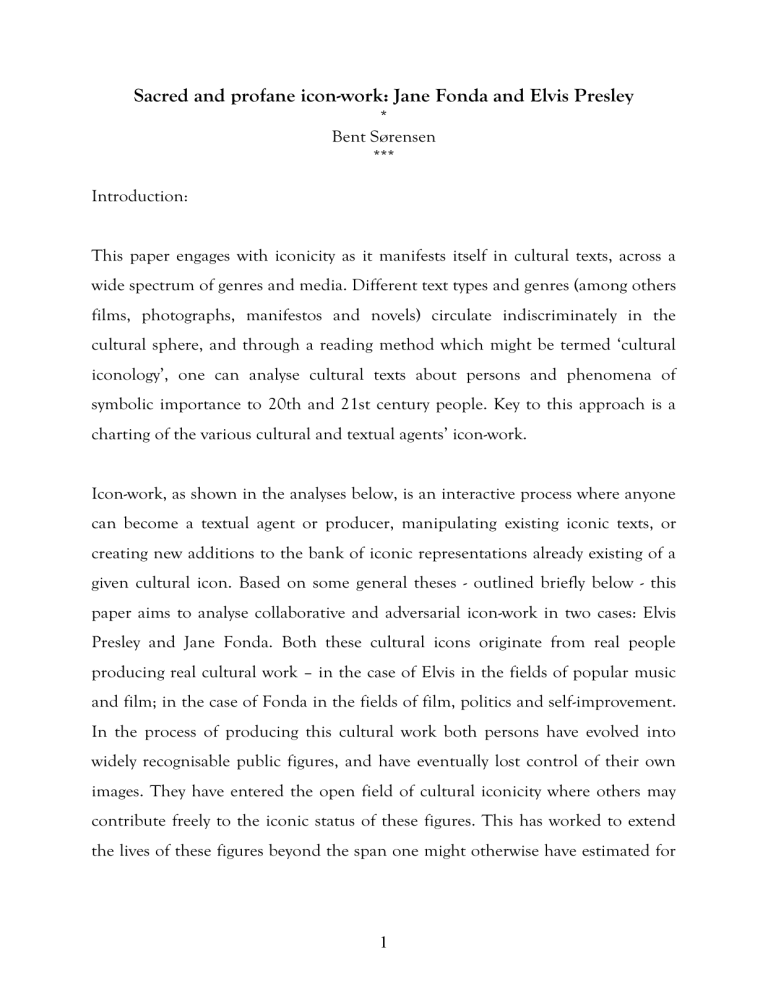
Sacred and profane icon-work: Jane Fonda and Elvis Presley
*
Bent Sørensen
***
Introduction:
This paper engages with iconicity as it manifests itself in cultural texts, across a wide spectrum of genres and media. Different text types and genres (among others films, photographs, manifestos and novels) circulate indiscriminately in the cultural sphere, and through a reading method which might be termed ‘cultural iconology’, one can analyse cultural texts about persons and phenomena of symbolic importance to 20th and 21st century people. Key to this approach is a charting of the various cultural and textual agents’ icon-work.
Icon-work, as shown in the analyses below, is an interactive process where anyone can become a textual agent or producer, manipulating existing iconic texts, or creating new additions to the bank of iconic representations already existing of a given cultural icon. Based on some general theses - outlined briefly below - this paper aims to analyse collaborative and adversarial icon-work in two cases: Elvis
Presley and Jane Fonda. Both these cultural icons originate from real people producing real cultural work – in the case of Elvis in the fields of popular music and film; in the case of Fonda in the fields of film, politics and self-improvement.
In the process of producing this cultural work both persons have evolved into widely recognisable public figures, and have eventually lost control of their own images. They have entered the open field of cultural iconicity where others may contribute freely to the iconic status of these figures. This has worked to extend the lives of these figures beyond the span one might otherwise have estimated for
1
them in an age of cultural acceleration. Both Fonda and Elvis are essentially figures of the 1950s and 60s, but today are perhaps more recognisable than ever.
The complex processes of icon-work have not previously been systematically theorised, and I cannot hope to do so exhaustively today. Still, the work may begin with the formulation of a set of theses regarding cultural iconicity, and that is my real starting point.
Theses
1. I propose that iconic representation combines two modes of representation: a stylised and a sacralised image of the person being iconised is presented. This duality originates in connotations of the word ‘icon’ from two spheres of use of the term: The commercial icon or pictogram which works through simplified representation (i.e. is stylised), and the religious icon, which works through embellished representation and through symbolic detail (i.e. is sacralised). An example of this duality can be given in the case of Marilyn Monroe: In Warhol’s silk-screens of her the face is represented as extremely stylised, with visual highlights of only those particular features of her that connote her role as
Marilyn: Her lips, her eye-shade, and most importantly, her beauty spot. In the well-known early Playboy nudes of Marilyn her body is sacralised through the use of luscious background colour and fabrics and a highlight of the very pinkness of her skin.
2. From the religious connotations of iconicity we as public inherit the position of worshipper. The need for icons is an expression of our longing for something beyond our own subject-hood, a desire to idolise. This need is no longer fulfilled in traditional religious ways, but has become transferred onto other
2
manifestations of the extraordinary. From the industrial, service and information oriented connotations of iconicity we inherit the position of consumer. Both these positions are especially well served by dead icons, which offer no active resistance to commodification.
3. Iconicity places us, as viewers and readers, in communication, and communion, with the person behind the icon, but – since we are not ourselves icons – a passive role is enforced on us as viewers or voyeurs. We may resist this role, but we are doomed to re-enact it whenever we commune with an icon. The relation between icon and viewer is basically unequal. Iconicity entails a reduction of the person behind the icon (the iconic subject) to image, to object. Iconicity thus becomes a form of martyrdom as a reduction or, more appropriately, translation from individuality to symbol. This causes problems for persons who become icons while still alive, since they experience an isolation from other people whom they only know as generic representatives of the voyeuristic gaze (the public, the audience, the fans – all terms for un-individuated masses). They must develop strategies for dealing with the public’s icon-work, and these can range from extreme use of irony as the young Bob Dylan did (see D. A. Pennebaker’s
1965 documentary film Don’t Look Back), to attempts at total isolation from the public gaze which many contemporary celebrities employ.
4. A person who achieves icon status has to be recognisable to the a large number of members of a specific group, whether that is a subculture (defined through age, race, class, belief etc.), a nation, or the global community: Iconicity presupposes immediate recognizability and familiarity. In apparent contradiction of the safety connoted by familiarity, the iconic person simultaneously has to be extraordinary, whether through his or her achievements, or through image. Some element of the person’s appearance, life, story or activities has to transcend the familiarity of
3
everyday life as lived by most of us: Iconicity presupposes transgression of normality. Ultimately, icon status is only achieved when the person imaged represents a combination of familiarity (which echoes in the word ‘fame’) and transgression of norms (often figured as ‘cool’).
5. The activities of the consumer of icons – in both senses of the word consumption – form what I term icon-work. It is convenient to subdivide this icon-work into two broad categories determined by the intention of the consumer, fan or icon-worker: adversarial and collaborative icon-work. By adversarial icon-work I understand the type of intervention which is aimed at destabilising or subverting the icon’s function and meaning in the icon-worker’s contemporary cultural reality. Icons, especially over-commercialised and overfamiliarised ones, tempt people into actively resisting them, e.g. by defacing them or tampering with them (slander, rumour-mongering, gossip, satire and cooptation are all possible strategies): The formerly passive worshippers then become iconoclasts. Collaborative icon-work, on the other hand, may take the form of homage, imitation, worship and activities to preserve the memory of the icon, etc. This form of activity is often the work of the ardent fan or follower of the icon’s original work. Most icon-work comprises a mixture of adversarial and collaborative efforts. All of these activities, whether adversarial or collaborative, ultimately serve only to perpetuate the iconic person’s status and longevity.
6. Largely due to the increased commodification and availability of icons, the need for worship has not diminished throughout the last 50 years, despite the apparent secularisation of the post WW II-era. On the contrary there are now more icons than ever, and despite the general tendency towards cultural acceleration, many icons formed in the 1950s and 60s are still potent and present in the commercial and cultural sphere. Iconicity serves as a form of immortality
4
(at least within a cultural or subcultural memory), yet, historically speaking, icons are always specifically situated and mean different things to different eras. Icons have a history, and not all icons are permanent, as witnessed by certain icons slipping out of a culture’s memory after some decades. Most silent film icons are no longer remembered as iconic by the larger public, and even such apparent immortals as Rudolph Valentino no longer elicits any response from the current student population. This final paradox of iconicity between immortality and historicity leads us to the analyses of two figures whose iconicity is linked to the
1950s and 60s, but who both still live on in the American cultural memory.
Analyses
1. Elvis Presley (whom for the purposes of this paper we shall presume dead) offers sterling examples of posthumous collaborative and adversarial icon-work.
Sacralised images, as well as other fetishised representations of Elvis’ body, proliferate. Brief analyses of Elvis as saviour and as object of consumption in
(un)holy communion will be supplied in the following analyses. In opposition to dead Elvis a still living iconic figure such as Jane Fonda can be read as a chameleonic re-inventor of self, strategically attempting to shed layer after layer of her public personae: Barbarella, Hanoi Jane, Work-out Jane etc. All these past personae will, however, be shown to remain in the public conscious as objects of fetishistic and adversarial icon-work, ranging from voyeuristic posters and websites devoted to Barbarella, via urinal-art depicting Jane Fonda in several of her personae, to tribute sites celebrating Fonda as an icon of eternal (sag- and wrinklefree) female youth. It is notable that at least 13 biographies of Fonda have appeared, but that none of them are currently in print – perhaps suggesting that her frequent changes of image rapidly diminish the shelf life of any potential biography.
5
Elvis Presley was a man of many comebacks and re-inventions of self. From his breakthrough as Rebel Elvis in 1956 to his death in 1977 he moved in and out of images and iconic figurations. His patriotic duty done after a stint as Army Elvis with a regulation GI-Joe haircut replacing his youthful and rebellious duck tail, he re-entered his long and successful second public career as Hollywood Elvis, acting in 31 movies in the years from 1956 - 1969. In 1968 he staged a spectacular televised comeback as Leather Elvis, creating perhaps the most durable iconic expression after the original Elvis-the-Pelvis, who was too hot for live TV in 1956.
In the Leather Elvis TV special Presley re-created his performance persona and reestablished his credibility as a rock performer.
This success led to a triumphant long-term engagement in Las Vegas, initially selling out 57 consecutive performances, followed by many subsequent month long bookings at the Las Vegas Hilton. Leather Elvis was transmogrified into
Vegas Elvis of the increasingly outlandish costumes and accessories. Another satellite transmitted TV-special brought about the birth of Hawaii Elvis in January
1973, where world-wide audiences saw him as the consummate patriot wearing his American Eagle jump-suit and marvelled at his command of a near-hysterical audience. Then came the decline, the ever expanding jump-suits as Elvis’ girth increased, and the inevitable death by burger-induced heart attack on August 16,
1977 in the isolation of Graceland, Elvis’ magical wonderland retreat away from the pressures of a too complex, too confusing world.
In the several thousand post mortem iconic representations of Elvis (Post Elvis, if you like) that have appeared since then, and continue to appear, a move has occurred more and more towards a canonisation of Elvis as a religious figure.
Vials of Elvis sweat can be bought on eBay, and scarves once worn by him are
6
considered as precious Veronicas. In the airbrushed painting, “Sacred Heart of
Elvis” by Christopher Rywalt (IMAGE 1), this is extremely obvious. The painting is a complete borrowing from Catholic sacred iconography, as we note in the representation of the halo, and the sign of the benefaction Elvis performs with his right hand. The radiant heart that illuminates Elvis’ chest appears to shine from within his holy body and to make his flesh transparent. Elvis is ready to embrace the viewer of the icon and bestow his blessings upon us.
This image is found in numerous places on the Internet, usually accompanied by other renditions of Elvis in saintly or outright Christ-like scenes (see for example
“Stations of the Cross of Elvis” at the same site) (IMAGE 2). I have collected it from a site entitled, “The First Church of Elvis”. The painting has also been used as cover art for the book, Elvis After Elvis: The Posthumous Career of a Living Legend by Gilbert Rodman, (Routledge, 1996), and is emblematic of the use of Elvis in crossover images between religious iconicity and cultural satire.
The reader of the icon can approach it as a sincere object of worship, and potentially include it in a shrine of Elvis (similar to the one the protagonist of
Laura Kalpakian’s novel Graced Land (1992) constructs on her porch), or else regard it as a commentary on the inappropriate mixture of religion and fandom that Elvis seems to spark among his most ardent followers. The intention is not immediately apparent from the image itself, as Elvis’ facial expression reveals little about the value the artist ascribes to the possibility of Elvis being a miraculous, saintly figure. In the image of Elvis as Jesus, carrying the cross, there is a greater misappropriation detectable through the presence of Elvis’ signature grin and gesture of salutation, which seems inappropriate in the context of the sufferer’s progression through the Stations of the Cross. These images teeter on the brink
7
of adversarial icon-work, but are still readable as tributes to the posthumous power of Elvis and Elvis’ body – for those who believe.
With a text such as Holme and Hooligan’s Presleyburger Shock (1977) (IMAGE 3) we have a clearer case of adversarial icon-work. The text sarcastically depicts the turning of Elvis’ body into a version of communion wafer of a kind more culturally appropriate for Elvis himself as well as for many of his worshippers: The burger. The satire is heightened by the suggestion that such Presleyburgers are consumed mainly by rock stars aspiring to attain Elvis’ greatness through this extreme form of cannibalistic communion. It is not the common fan who eats
Presleyburgers, but “rock aristocracy” who partake of the feast. Thus even an apparently clear-cut case of adversarial satire turns out to have a kernel of homage in it, since the suggestion seems to be that even the dead body of Elvis contains more true rock’n’roll than the living specimens of ageing rockers such as Cliff
Richard possess.
Both sets of iconic representations of Elvis have elements of the sadistic in them.
The desire to cannibalise Elvis’s body is overt in the latter example, but even in the religious iconography analysed above we detect a desire to inflict stigmata on the body of Elvis, and of course to control Elvis as a translated, but permanently dead figure. Thus both texts objectify Elvis in their icon-work, continuing the reifying tendency initiated by the metonymic reduction of Elvis to pure Pelvis begun with his 1950s nickname. The transgressive element in both iconic texts is equally evident and foregrounded in the taboo breaking nature of the texts’ flirtation with cannibalism and necrophilia, not to mention the sacrosanct playing around with Christian iconography and doctrine. The texts tantalise us by promising to dissolve the distinction between icon and worshipper and release us
8
from our passivity as viewers of the icon: one by offering that we may eat Elvis, the other by offering that Elvis will protect us and eventually guide us to Heaven.
It should be added that many less ambiguous iconic representations of Elvis may be found, among them many evidently sincere tributes. There is a spate of mystery novels and comic books where Elvis is the hero and fights crime, much as the real
Elvis once expressed a wish to do when hosted by President Nixon in the White
House. Likewise there are a number of images teaming Elvis up with other icons, especially Marilyn Monroe, whom icon-workers seem to particularly want to have a relationship with Elvis. Nowhere is this more explicit than in Catherine Deeter’s image (1986) (IMAGE 4), an illustration for Mark Shipper’s book How to be
Ecstatically Happy 24 Hours a Day for the Rest of Your Life. Here we have the two of them in bed together – both reduced to their stylised icon-hood: Elvis as forelock, crooked smile and torso; Marilyn as smile, closed eyes, glossy lips, blonde hair and beauty spot, and both ecstatic either in anticipation of sexual union or as a result of already having consummated this union. This collaborative icon-work can surely only serve to also make the viewers feel happy, and possibly to entice them to buy this obviously potent volume which posthumously has cured two of the most notoriously depressed media stars in the American pantheon. Thus this iconic representation illustrates the consumer use Elvis can be put to, quite isolated from the core commerciality of the still burgeoning industry of repackaging and re-releasing products actually featuring Elvis’ voice or acting.
2. When Elvis “left the building” in 1977, Jane Fonda was nearing the height of her acting career. The following year she won her second Oscar for her work in
Coming Home, a movie about the trials and tribulations of a returning Vietnam veteran. The irony of this role cannot be lost on anyone who has followed
Fonda’s political activism throughout the late 1960s and early 70s, where she
9
earned the nickname “Hanoi Jane”, due to her support of the North Vietnamese
(Viet Cong) soldiers. While in Vietnam she was memorably portrayed on the seat of an anti-aircraft gun in full military gear, apparently ready to shoot down her fellow countrymen in their magnificent flying machines (IMAGE 5). These images and Fonda’s refusal to ever apologise unreservedly for her anti-war and anti-
American stance during the Vietnam War have combined to create a lasting hatred of Fonda among many Vietnam veterans. Their adversarial icon-work has created some of the most provocative images of Fonda available.
But nothing in Fonda’s early career as a pretty ingenue appearing in numerous lightweight Hollywood films (such as 1963’s Sunday in New York and 1965’s Cat
Ballou) prepared her audience for her later transgressions. Her first signature role came when she was cast by her husband (from 1965 to 1973), Roger Vadim, in his 1968 sci-fi comedy Barbarella (IMAGE 6). This movie is memorable chiefly for its loving display of Fonda’s body in a number of sado-masochistic situations and settings, not least in the scene where the villain Durand-Durand attempts to kill
Barbarella with an orgasm organ. The beginning of the movie shows Fonda’s character awakening in her space ship, floating weightlessly in the cabin, which weirdly is a fur-covered nest-like room. Barbarella is undressing and Fonda’s bottom is caressingly displayed by the camera in slow motion. The reintroduction of gravity causes Barbarella to rudely land on said bottom, and marks the first instance of a sadistic probing into the character’s bodily state. The film has become a cult classic sparking several tribute web sites, as well as an imminent sequel featuring Drew Barrymore in the role of Barbarella. Posters displaying
Fonda in Barbarella costumes with phallic weapons in her hand are sold at high prices on the Internet, especially from sites in France and Japan.
10
A curious intersection with contemporary American politics is created by the image and text on the cover of Life in March 1968 (IMAGE 7), where a typical
Barbarella still (by Carlo Babagnoli) is juxtaposed with several apparently related captions. First, “The Deciding Days”, (actually referring to the potential
Rockefeller vs. Kennedy battle for the American Presidency in November 1964), where it seems Barbarella wielding her gun might legitimately have a say in the decision. Then, “3 ½ Super Powers”, which obviously leads one to think of the arms race and wonder if Barbarella might be the ½ super power one had not previously heard of. But the real caption to the cover image is of course, “Fonda’s
Little Girl Jane” which continues the sadistic reduction of Fonda’s character to that of a child – an altogether unsavoury association, considering the sexual display the character of Barbarella evinces in the movie.
At this point in the late 1960s and early 1970s Fonda was developing strong antiwar sentiments, coinciding with her relationship and next marriage (1973 – 1989) to outspoken anti-war writer and activist, Tom Hayden. She began speaking on college campuses (IMAGE 8) and was arrested on a few occasions, which led to memorably iconic images, again displaying a Fonda in bondage – handcuffed, but extremely well made-up in Ohio 1970 (IMAGE 9). In the mug shots taken after her arrest in Cleveland November 1970 (IMAGE 10), she is seen in full make-up and wearing a ladylike wristwatch, simultaneously displaying a well-manicured fist in a strange imitation of a black power salute.
To briefly return to the infamous anti-aircraft image (IMAGE 5), we there see
Fonda surrounded by male figures, all with their attention riveted upon her, several of them poking objects or their hands in her general direction. It actually seems that Fonda is entrapped in the machinery of the gun, rather than being in charge of eventually discharging it. The male figures are attempting to manipulate
11
her much in the same vein that Durand-Durand manipulated her in his orgasm machine. The sado-masochistic imagery duplicates itself again in the political and military context of this image.
Another example of iconic use of the politicised Jane of the 1970s, and again one that privileges the male, sexualised gaze is found in Raymond Federman’s postmodern meta-novel The Twofold Vibration from 1982. Here the novel’s protagonist, ‘the old man’ (a rather ’dirty’ old man, in fact), elopes from Buffalo,
New York, ”the armpit of America,” (Federman, 32) to Europe with a thinly veiled Jane Fonda-like character, called June Fanon. This act is motivated by his assertion that “most of us live our politics in the past” (Fanon replies: “Or in the future”) (79), and that “political understanding is but a series of second thoughts”
(68). Both characters escape from radical political involvement in the counterculture of early 1970s USA: Fonda/Fanon is already planning the emotional depths of future film roles (her Oscar winning performance in Coming
Home (1978)); ‘the old man’ is dreaming of again winning a fortune in Monte
Carlo. In the greater scheme of the novel, these future schemes and past reminiscences are more substantial than the characters’ present activism.
However, their trip evolves into a true journey of remembrance for ‘the old man’, taking him from the casino tables to the Nazi death camps, whereas
Fonda/Fanon’s political activism is really just a future oriented publicity strategy which only leads back to Hollywood.
Not only is Fonda’s radicalism scoffed at in the novel, but her appearance is extremely sexualised, whereas her political speech consists solely of these words repeated thrice: “Hello There Fellow Bums” (43). It doesn’t really matter what she says, since the entire audience is focussed on her body, not her words: “[S]he stood on the platform in a mini-skirt and leather boots, the style that year, her
12
reddish hair flowing wildly in the breeze, legs spread apart in sensual defiance”
(41). We recognise the representations of Fonda’s body from her Barbarella persona in this description. ‘The old man’ enjoys sitting behind her on the platform: “having a splendid view of her intense liberal position” […] “legs provocatively spread apart” (42). The conflation between political position and sexual position is complete in Federman’s witty satire of Hollywood activism. The novel shows that iconically Fonda of the 1960s and the 1970s cannot be kept separate in the public gaze, nor can the later images of her 1980s aerobic body be excluded from the iconography of long, spread legs, phantasmagorically evoked by
Federman.
In the 1980s Fonda re-invented herself as an icon of youthfulness and fitness, choosing to project an image which belied her actual age. Her work-out programs on video and described in several books laid out a potential route towards eternal youth for needy women, and Fonda’s fame for the first time became truly international. The aerobics products continue to be a money-maker for Fonda, now supplemented with treatments, creams and other accessories. The trademark images associated with the aerobics products display Fonda doing stretches, splits and high kicks (IMAGES 11 & 12) that all echo the body postures we already are familiar with from her glamour stills from the early sixties (long legs) and from
Barbarella (exposure of buttocks and genital area). The inevitable association is sexual and specifically masochistic. The viewers of the images are invited to speculate about the pain such postures would inflict on their own bodies and must have inflicted on Fonda’s as well. These images are therefore also ripe for adversarial icon work, deliberately emphasising the potential for sadistic overlayering of the masochistic subtext.
13
As always with Fonda her choice of husband in this period seems designed to highlight her current involvement. Seen side by side with her 3 rd husband (1991-
2001), Ted Turner, the media mogul of Atlanta, she displays herself as a stylish lady, but one distinctly younger than him. She has even found a patriotic side to her personality as she has moved upward within the American establishment.
(IMAGE 13)
The final icons we shall analyse in regard to Jane Fonda are those adversarial and sadistic images produced by vengeful veterans of the Vietnam War. On Mike
Fatey’s anti-Jane web site one finds a number of items of merchandise which express the seller’s views of Fonda as a perpetrator of high treason. I here display two so-called “urinal stickers”, meant apparently to be affixed to urinals in men’s rooms and peed on (IMAGES 14 & 15). This extreme humiliation is of course overtly sexual and violent in nature. This is further underlined by the captions using the word “Target”, which evokes other missiles than urine drops, namely bullets from firearms. Especially the image featuring the concentric circles associated with a target in a firing range shows this association to be intentional on the part of the icon worker. The sexual crudeness of the icons is of course increased by the fact that the “arm” pointing towards the representation of Fonda in the targets is the male penis. The viewer of the urinal target is being offered the opportunity to violate Fonda with his sexual organ. The round target image invites oral rape of the Fonda face (copied from her image at the anti-war speech at Bowling Green University), whereas the oval image, displaying Fonda in her workout outfit, invites rape of her genital area, highlighted between her open, stretched-out legs.
This overt sadism is of course shocking, but before we condemn it outright, we should reflect upon the history of sado-masochistic representations of Fonda,
14
some of them self-engineered by her, others created by her male companions and husbands, and note that sadistic images seem almost overdetermined as the form of consumption of choice of the body of “little girl Jane”.
Conclusion
To conclude, I would claim that I have shown how these two cases reveal that iconic representations accumulate and form coherent streams of iconicity through the life and after-life of persons submitted to iconic treatment. Icon-work can be traced and categorized according to various forms of commodification and consumption – whether it be orally, as in the case of Elvis Presley, or, predominantly, genitally, as in the case of Jane Fonda. Both icons have reinvented themselves over and over in the course of their careers, but the patterns of iconic manipulation have in both cases remained strikingly stable. Elvis’ has become metonymically associated with his own body parts in a stylising move, yet after his death the sacralised mode of representation has become fused with the oral, metonymic body representation, and this has created the close parallel between the Church of Elvis and the Church of Christ. Fonda’s pattern of sadomasochistic roles has repeated itself with frightening regularity, and while sexuality has at times been a weapon for her in her apparent crusade against ageing and typecasting, she has also inadvertently cast herself in subservient roles inviting voyeuristic or sexually violent interventions on the part of her audience.
The adversarial icon-work of angry revengists illustrates this pattern of vulnerability and victimisation all too clearly.
15
Bibliography
Works cited:
Federman, Raymond: The Twofold Vibration (Green Integer 2000, (1982))
Holme, Ray & Hooligan, Joby: Presleyburger Shock (1977), in Pic of the Poseurs –
Magazine for Modern Youth (London, 1977)
Kalpakian, Laura: Graced Land (Blue Heron Pub., 1992 (reprint 1997))
Rodman, Gilbert: Elvis After Elvis: The Posthumous Career of a Living Legend
(Routledge, 1996)
Shipper, Mark: How to be Ecstatically Happy 24 Hours a Day for the Rest of Your Life
(809 Productions, 1986)
Suggestions for further reading:
Anderson, Christopher: Citizen Jane: The Turbulent Life of Jane Fonda (Virgin
Books, 1990)
Dyer, Richard & McDonald, Paul: Stars (British Film Institute, 1998 (2 nd ed.))
Dyer, Richard: The Matter of Images: Essays on Representation (Routledge, 2002)
Fischer, Olga & Nänny, Max (eds.): Form Miming Meaning: Iconicity in Language and
Literature (John Benjamins Publ. Co., 1999)
Fischer, Olga & Nänny, Max (eds.): The Motivated Sign: Iconicity in Language and
Literature 2 (John Benjamins Publ. Co., 2002)
Fonda, Suzanne: Jane Fonda’s Workout Book (Fireside, Reprint ed., 1984)
Heck, Thomas: Picturing Performance: The Iconography of the Performing Arts in Theory
and Practice (U. of Rochester Press, 1999)
Holzer, H.M. & Holzer, Erika: Aid and Comfort: Jane Fonda in North Vietnam
(McFarland & Co., 2002)
16
Kelly, Michael: Iconoclasm in Aesthetics (Cambridge University Press, 2003)
Marcus, Greil: Mystery Train: Images of America in Rock’n’Roll Music (E.P. Dutton,
1975)
Marcus, Greil: Dead Elvis: A Chronicle of Cultural Obsession (Harvard University
Press, 1999)
Plasketes, George: Images of Elvis Presley in American Culture 1977-1997: The Mystery
Terrain (Haworth Press, 1997)
Wagner, Peter (ed.): Icons – Texts – Iconotexts: Essays on Ekphrasis and Intermediality
(W. de Gruyter, 1996)
List of images:
1. Christopher Rywalt: Sacred Heart of Elvis http://jubal.westnet.com/hyperdiscordia/sacred_heart_of_elvis.jpeg
2. Christopher Rywalt: Stations of the Cross of Elvis http://jubal.westnet.com/hyperdiscordia/large_cross_elvis.gif
3. Holme, Ray & Hooligan, Joby: Presleyburger Shock (1977), in Pic of the Poseurs –
Magazine for Modern Youth (London, 1977)
4. Catherine Deeter: How to be Ecstatically Happy 24 Hours a Day for the Rest of Your
Life
5. Fonda in Vietnam, photographer unknown, AP
6. Still from Barbarella, photo by Carlo Babagnoli
7. Cover of Life, March 29, 1968, photo by Carlo Babagnoli
8. Fonda in Ohio, photo by John Cessna
9. Fonda arrested, photographer unknown
10. Fonda mugshot, November 3, 1970, photographer unknown
11. Aerobics, photo by Harry Langdon
17
12. Splits, photo by Dick Zimmerman
13a. Fonda and Turner, photographer unknown
13b. Patriotic Fonda, photographer unknown
14. Urinal sticker, artist unknown (composite of Ohio image by John Cessna)
15. Urinal sticker, artist unknown (composite of Aerobics image, photographer unknown)
18
